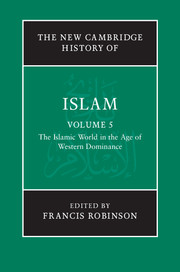Book contents
- Frontmatter
- Introduction
- PART I THE ONSET OF WESTERN DOMINATION C. 1800 TO C. 1919
- 1 The Ottoman lands to the post-First World War settlement
- 2 Egypt to c. 1919
- 3 Sudan, Somalia and the Maghreb to the end of the First World War
- 4 Arabia to the end of the First World War
- 5 Iran to 1919
- 6 Russia, Central Asia and the Caucasus to 1917
- 7 Afghanistan to 1919
- 8 South Asia to 1919
- 9 South-East Asia and China to 1910
- 10 Africa south of the Sahara to the First World War
- PART II INDEPENDENCE AND REVIVAL C. 1919 TO THE PRESENT
- Glossary
- Bibliography
- Index
- References
1 - The Ottoman lands to the post-First World War settlement
from PART I - THE ONSET OF WESTERN DOMINATION C. 1800 TO C. 1919
Published online by Cambridge University Press: 28 March 2011
- Frontmatter
- Introduction
- PART I THE ONSET OF WESTERN DOMINATION C. 1800 TO C. 1919
- 1 The Ottoman lands to the post-First World War settlement
- 2 Egypt to c. 1919
- 3 Sudan, Somalia and the Maghreb to the end of the First World War
- 4 Arabia to the end of the First World War
- 5 Iran to 1919
- 6 Russia, Central Asia and the Caucasus to 1917
- 7 Afghanistan to 1919
- 8 South Asia to 1919
- 9 South-East Asia and China to 1910
- 10 Africa south of the Sahara to the First World War
- PART II INDEPENDENCE AND REVIVAL C. 1919 TO THE PRESENT
- Glossary
- Bibliography
- Index
- References
Summary
Among Islamic states, the Ottoman Empire was the longest-lived and one of the largest. Surviving into the age of European imperialism, the Ottomans continued elaborating the Islamic and Turkish traditions of statecraft into the twentieth century, even as they underwent the metamorphic pressure of emergent global modernity. Imperialism and separatist nationalism presented the threatening guise of modernity to the Ottomans. They also saw the attractive aspects of modernity that had emerged from Europe’s economic and political revolutions. Oppressed like other societies by their sense of backwardness compared to the most advanced nations, Ottomans strove to adopt elements of modernity that could protect the empire from the threats that other aspects of modernity posed to it.
The empire increasingly displayed a doubly imperial character: it was a multinational empire threatened by nationalism and European imperialism. This duality made late Ottoman history a story of dynamism amid disintegration. Both require recognition. Among constructive developments, Ottoman Muslims’ responses to the challenges they faced gradually generated two great currents of change. One of these favoured disruptive change and a rapid advance towards modernity; the other favoured an accommodative, Islamically committed advance. The currents formed and differentiated gradually, creating a dialectic that shaped Turkish history under both empire and republic. This chapter examines the political, social, economic and cultural evidence of four periods: those of sultans Selim III and Mahmud II (1789–1839); the Tanzimat (1839–1870s); Abdülhamid II (1876–1909); and the Young Turk revolution and final crises (1908–22).
- Type
- Chapter
- Information
- The New Cambridge History of Islam , pp. 29 - 78Publisher: Cambridge University PressPrint publication year: 2010

